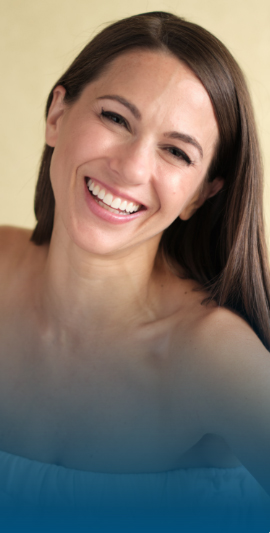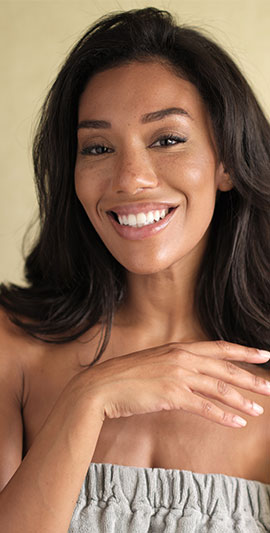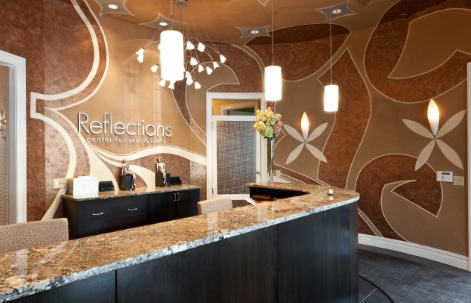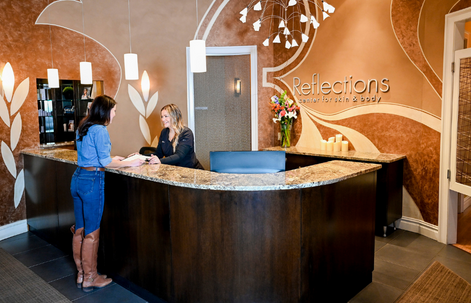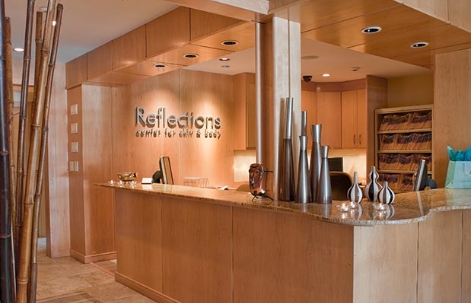What Makes Filler Look Natural?
We all know “bad filler” when we see it, but what exactly makes it look so unnatural? Most people assume that unnatural or bad filler results are because too much filler was used, but this isn’t always true. In some cases, you can have a bad result because your injector doesn’t understand the natural proportions that best suit your race or genetic makeup. The typical proportions of your race and genetic heritage play a large role in maintaining a natural-looking yet enhanced result from injectable fillers.
Scientific studies have been conducted to determine the typical facial feature proportions for men and women of various genetic backgrounds. It’s important to remember that there is no particular set of facial features or racial background that makes one person or group more beautiful than the other, and that so many of us are from a mixture of various groups, and that almost no one perfectly fits these proportions (nor do we all want to look like a single, standardized version of “beauty”), so there is a real need for the cosmetic physician to use an artist’s eye to enhance the individual in a natural way. At Reflections Center, our physicians and staff value the unique beauty of every patient, and understand that as cosmetic professionals, it’s our job to combine knowledge of science and art to enhance your features.
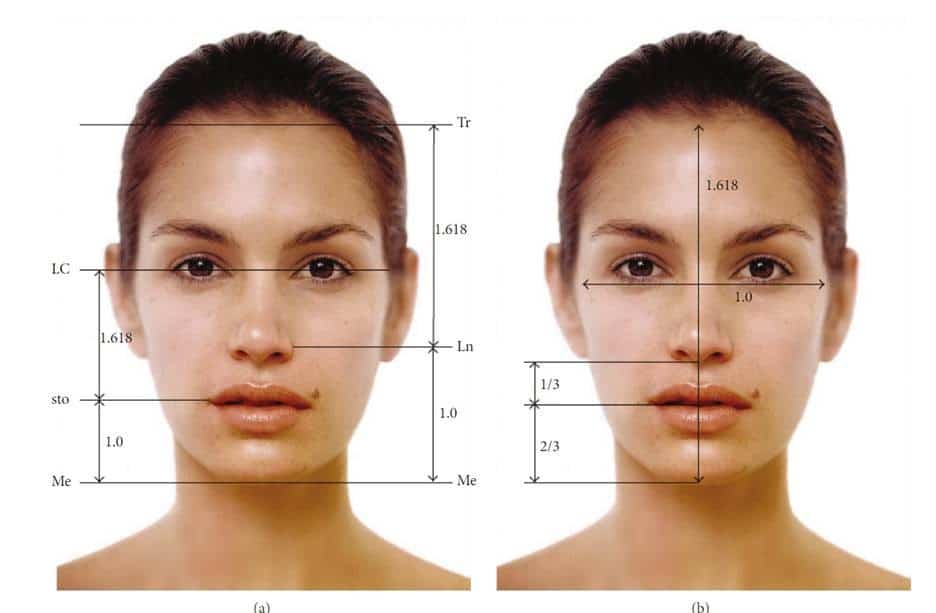
The Golden Ratio: Phi Proportions as a Standard of Beauty
Studying balanced or typical facial features is an expanding field, because for years artists and scientists followed the golden ratio, or Phi, as the standard of beauty. However, this standard is only useful for Caucasian faces, so it’s important and exciting to see new research emerging to suit a more diverse standard of beauty.
In addition to expanding beyond the golden ratio, there is growing evidence that American beauty standards are moving towards a mix of features from various ethnic and racial backgrounds. A 2011 study found that in modern America, women who are considered beautiful tend to have similar facial features which are a mix of both Black and white features, especially in the lower face.3
Essentially, what this means is that you can take most of this information with a grain of salt and with the understanding that getting filler right comes down to a combination of knowledge on science and art. What’s most important is that your injector looks at your individual features and understands how to enhance them in a holistic way for natural-looking results.
Lip Filler Proportions
Most people recognize Kylie Jenner as starting the lip filler trend, but you may also take note of other famous celebrity lips, such as Angelina Jolie, Amanda Seyfried, and Priyanka Chopra. It’s important to note that each of these women have different ethnic and racial backgrounds, which plays a role in determining the ratio between their upper lip and lower lip that looks most natural on them. However, the beauty standards of the society we live in also influences our preferences.
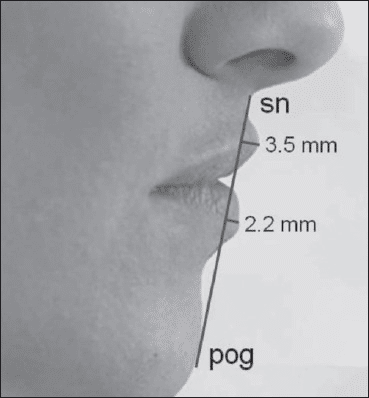
There are three considerations your injector takes when adding filler to the lips: protrusion, total height, and proportion.
Proportion is a comparison of the total volume, not just the height, between the upper and lower lip. In Caucasians, the ideal proportion is 1:1.6, or Phi. This “Golden ratio” was discovered by Leonardo DaVinci, so it makes sense that as a European, his standard applies only to people with European heritage. However, we now have a better understanding of ideal proportions for people of other backgrounds as well. Among Asians, 1:1.251 is thought to be the ideal, and most believe that the ideal lip ratio for Black women is 1:1, however, research is lacking.
In addition to these findings, popular opinions can shift according to trends or other factors. For example, a recent study found that women of all races now tend to prefer a 1:1 lip ratio.7 Similarly, studies find that Korean women prefer fuller lips than Japanese women, even though women of these groups tend to have overall similar natural lip proportions.1
Protrusion is correlated to the overall size of the lips. It’s uncommon for a much larger lip to be as flat as a smaller lip, because the soft tissue tends to form a roll of sorts. Protrusion can vary among different ethnic or racial groups. Hispanic women tend to have lips that protrude 2-3 mm more1 per lip than Caucasians, even though their lips tend to have little natural size difference. Both Black and Asian women tend to have larger lips than their White counterparts, however, so their lip projection tends to be larger as well. Black Americans tend to have lips that are about 8mm larger in total than Whites, which is about 1/3 of an inch difference. Finally, women overall typically have larger lips than men.
The common lip heights for different races and ethnicities are as follows:
- Black North American Females – Upper Lip Height: 13.6 mm / Lower Lip Height: 13.8 mm
- White North American Females – Upper Lip Height: 9.3 mm / Lower Lip Height: 9.4 mm
- Black North American Males – Upper Lip Height: 13.3 mm / Lower Lip Height: 13.2 mm
- White North American Males -Upper Lip Height: 8.0 mm / Lower Lip Height: 8.7 mm
To maintain a natural and proportionate appearance, your injector will consider all of these factors and balance the lips with your eye size and the rest of your facial features.
Cheek Filler Proportions
It may be surprise you to learn that White and Black North Americans have similar facial proportions along the vertical axis, but are very different along the horizontal axis.6 Black Americans tend to have similar facial proportions to some, but not all, Africans. Their proportions are more similar to Kenyan women as compared to Sudanese women, who typically have taller and narrower faces, for example.5
When considering making changes to look more beautiful, it’s important to consider what’s within the range of “normal” or “natural” for your own genetic background. Generally, ethnic or racial groups with wider or more pronounced “cheekbones” have more bony support than other races, meaning that they lose fullness in their cheeks slower over time, as compared to those who have more forward projection in their cheeks, which is usually a fat prominence and fades early on in life. Studies have shown Asian women, similarly to Black Americans, also tend to have a flatter and wider cheek in their youth. This explains why cheek filler is so often something that White American women seek out, but is not as popular in other races – and rightly so!
White women with too much filler in their cheeks tend to look “overdone” and strange because your eye is not used to seeing white women with such large or wide cheeks. This phenomenon is partly due to the popularization of a concept that filler placed in the far back corners of cheeks, near to the temple, can provide more lift than filler places in the front of the cheek. Commonly, White women’s cheeks project forward in the malar region more than Black women’s, but their cheeks are not as pronounced from the front view.9 This injection technique has been abandoned by the top injectors in recent years, in favor of others that create more natural results and more specific to the individual being treated.
Jawline Filler Proportions
Sculpted and angular jawlines are very on-trend, but don’t always suit every face shape and are not preferred in every culture. For example, many Chinese women prefer rounder faces, which is more common among this background.
From a side view, White women who are considered attractive tend to have a more prominent chin than attractive Black women.9 This is an important consideration in creating natural results for patients interested in jawline filler.
Schedule a Consultation
With all of these statistics and facts in mind, it’s important to choose an injector who understands the small details of proportion, anatomy, and enhancing your natural beauty. These factors are all taken into consideration by our team at Reflections Center, and you can rest assured that your results will be natural-looking and subtly beautiful. Contact us today to schedule your free consultation!
Sources Cited:
- Ramya Kollipara, MD, Bridget Walker, BA, and Ashley Sturgeon, MD; Lip Measurements and Preferences in Asians and Hispanics: A Brief Review J Clin Aesthet Dermatol. 2017 Nov; 10(11): 19–21. Published online 2017 Nov 1.
- M. KAR, N.B. MULUK, S.A. BAFAQEEH, and C. CINGI; Is it Possible to Define “Ideal” Lips?; Acta Otorhinolaryngol Ital. 2018 Feb; 38(1): 67–72. doi: 10.14639/0392-100X-1511
- Alejandro Rosa-María Yáñez-Vico BDS, MSc, BlancaMoreno-Manteca BDS, Ana María Moreno-Fernández MD, MSc, Asunción Mendoza-Mendoza MD, MSc, Enrique Solano-Reina MD, MSc; Common Standards in Facial Esthetics: Craniofacial Analysis of Most Attractive Black and White Subjects According to People Magazine During Previous 10 Years; Journal of Oral and Maxillofacial Surgery, Volume 69, Issue 6, June 2011, Pages e216-e224
- Cosmetic Lip Surgery, Chapter: Marcocheilia; Joe NiamtuIII, in Cosmetic Facial Surgery (Second Edition), 2018
- Virdi, S.S., Wertheim, D. & Naini, F.B.; Normative anthropometry and proportions of the Kenyan-African face and comparative anthropometry in relation to African Americans and North American Whites; Maxillofac Plast Reconstr Surg (2019) 41: 9. https://doi.org/10.1186/s40902-019-0191-7
- Jeffries JM 3rd, DiBernardo B, Rauscher GE (1995) Computer analysis of the African-American face. Ann Plast Surg 34:318–321
- Paul I. Heidekrueger, Sabrina Juran, Caroline Szpalski, Lorenz Larcher, Reuben Ng P. Niclas; The current preferred female lip ratio; Journal of Cranio-Maxillofacial Surgery; Volume 45, Issue 5, May 2017, Pages 655-660
- Milutinović, J., Zelic, K., Nedeljkovic, N.; Evaluation of Facial Beauty Using Anthropometric Proportions; The Scientific World Journal 2014(2):428250 · February 2014; DOI: 10.1155/2014/428250
- Talbert, L., Chung, K.H., Christou, T., Viachos, C.; A 3D analysis of Caucasian and African American facial morphologies in a US population; Journal of Orthodontics; 41(1):19-29 · March 2014; DOI:1179/1465313313Y.0000000077
- Baudouin JY, Tiberghien G. Symmetry, averageness, and feature size in the facial attractiveness of women. Acta Psychol (Amst). 2004 Nov;117(3):313-32.


